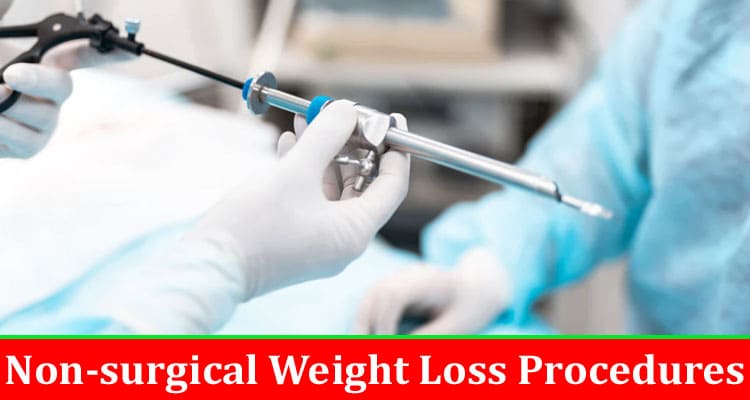Many people who want to lose weight are unable or unwilling to undergo surgery. For these individuals, the best non-surgical weight loss procedures offer a safe and effective way to achieve their goals.
These endoscopic procedures use one or more balloons that doctors insert through the mouth and esophagus and fill with saline. They limit the amount of food someone can eat and achieve better results than medication alone.
Intragastric Balloon
This non-surgical weight loss procedure involves placing a soft silicone balloon in your stomach. It’s filled with saline solution (salt water) to occupy space in your stomach, helping you feel full after smaller meals. You’re asleep during the process, which usually takes less than 30 minutes. The balloon is injected into your stomach via a tiny tube passed through your mouth.
The balloon is usually removed after six months. While it’s in place, you’ll receive diet and exercise coaching from experts, including dietitians, psychologists, and exercise physiologists. This support will help you overcome barriers to meeting your long-term goals.
While the balloon is in place, you must eat only liquids. Once your stomach adjusts, you’ll advance to a soft food diet before moving on to a normal long-term diet. Your doctor will monitor your progress to ensure the balloon works as expected.
There is a slight risk that the intragastric balloon can migrate into your intestines, causing a blockage. Most balloons have a tracking device that alerts the medical team if this happens. A rare but serious problem called hyperinflation may also occur when the balloon malfunctions and overfills. This can cause persistent gastrointestinal symptoms and requires another endoscopy to correct. Luckily, most of these complications are minor.
Gastric Bypass
Gastric bypass surgery is a surgical procedure designed to help patients lose weight quickly by restricting how much food they can consume and reducing how many calories are absorbed by the small intestine. The procedure is typically performed with a laparoscopic technique through tiny incisions in the stomach. The surgeon will insert a scope and tools through these cuts, making the surgery minimally invasive.
Your stomach will be divided into a bigger lower region that can store less than an ounce of food and a smaller upper section during the procedure using surgical staples. The surgeon will next attach the upper section of the small intestine to this new stomach pouch. Bypassing both the initial part of your intestine and the majority of your stomach.
This type of surgery is typically only used for patients who are severely obese, meaning they have a BMI of over 30 or more. This includes people suffering from obesity caused by metabolic syndrome associated with high blood pressure and Type 2 diabetes.
You will be placed under general anesthesia during the surgery and feel no pain. Once the surgery is complete, you can start eating slowly and introducing solid foods as your stomach gets accustomed to it. Potential risks of this procedure include a narrowing of the connection between the stomach and small intestine (stomal stenosis) and vitamin/mineral deficiencies due to a reduction in nutrient absorption.
Sleeve Gastrectomy
This weight loss surgery reduces the stomach’s capacity to hold food, helping you feel full after smaller meals. It also decreases appetite and hunger by reducing levels of the hormone ghrelin. This surgical procedure can also improve or resolve many health conditions caused by obesity, including diabetes, high blood pressure, and sleep apnea.
By eliminating around 80% of the stomach, the gastric sleeve is a minimally invasive treatment that decreases the stomach’s capacity to retain and absorb food. This enables patients to choose nutritious foods and avoid overeating by making them feel satisfied after a small amount of food. People who have a BMI of 40 or above and a medical problem like type 2 diabetes, high blood pressure, or sleep apnea may elect to do it.
Aside from its effect on appetite, sleeve gastrectomy also decreases blood sugar levels and helps improve glucose control in diabetics. It also improves lipid metabolism by decreasing triglycerides and LDL cholesterol and improves cardiovascular risk factors such as hypertension and dyslipidemia.
As with any weight loss surgery, there are risks associated with sleeve gastrectomy. The most common problems include leaking from the new connection between the stomach and intestine or between two parts of the intestine, which can cause severe symptoms, including abdominal pain, nausea, vomiting, fever, and infection.
Suture Sculpt ESG
This minimally invasive procedure is similar to a gastric sleeve surgery, except it does not involve cutting through the stomach. It is done on an outpatient basis with a short recovery time and no restrictions on physical activity. The ESG procedure reduces the stomach’s volume, limiting how much food a patient can consume at one meal and encouraging portion control. This leads to significant weight loss results.
For individuals with a BMI of 30 or above who have not seen success with diet and exercise alone, ESG is more beneficial than other surgical procedures. It is also a secure alternative for people who cannot or do not want bariatric surgery because of medical issues.
After this non-invasive treatment, patients will spend a few hours in the hospital monitored by a medical team. However, recovery is much faster than a surgical procedure, so that patients can return to their daily activities within a few days.

